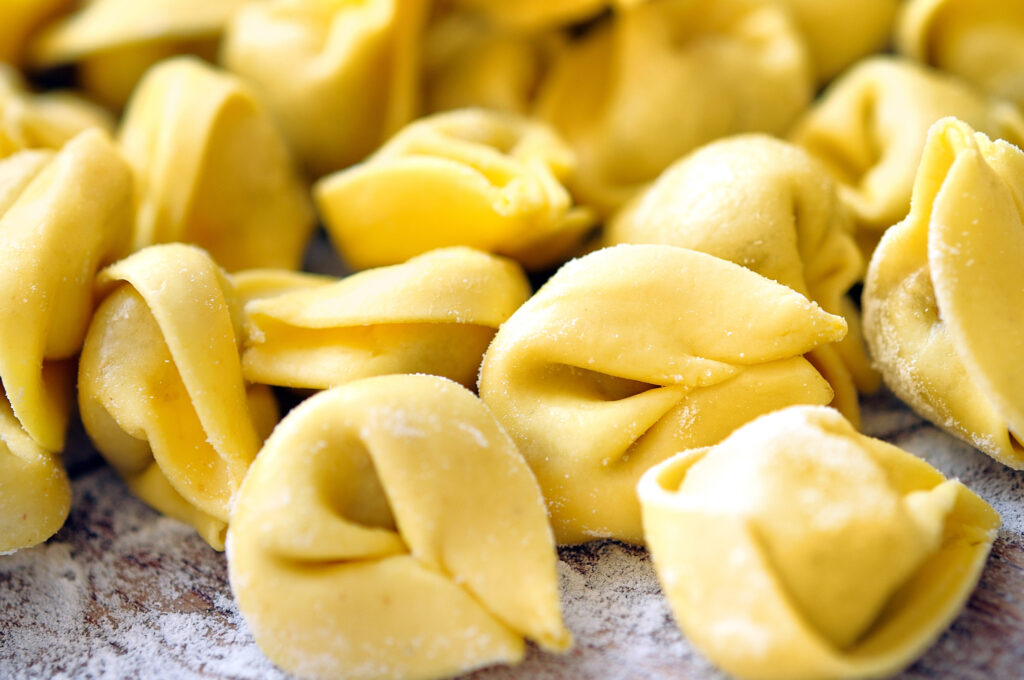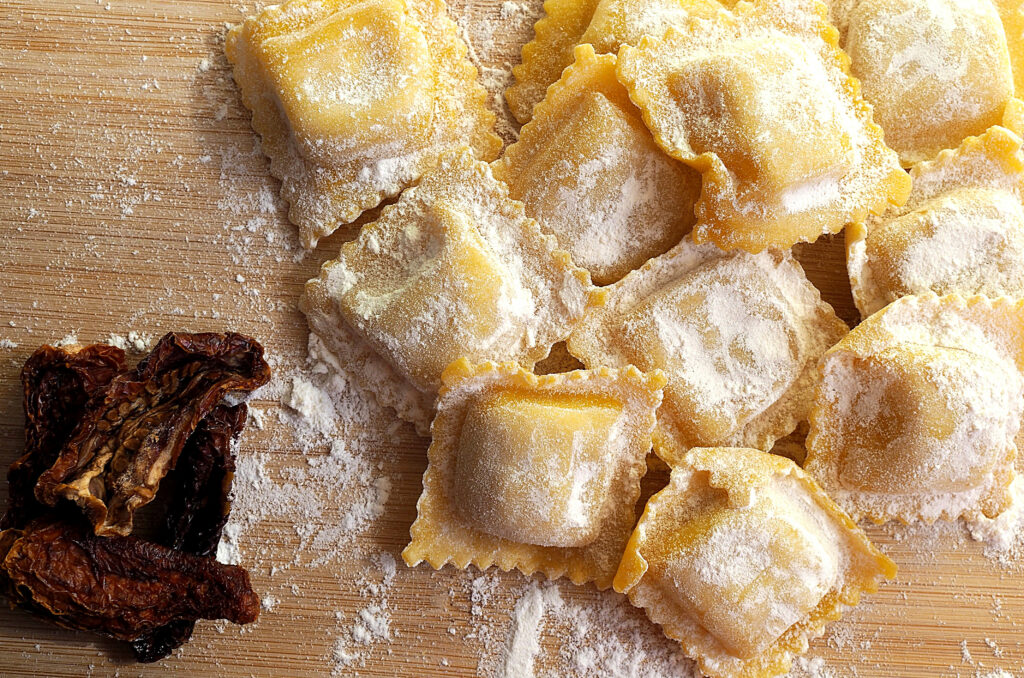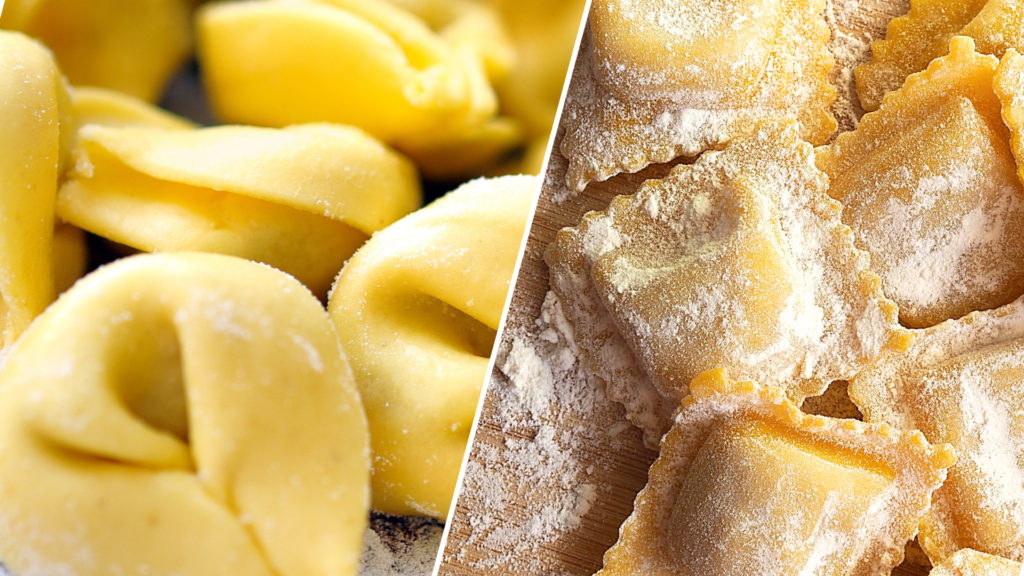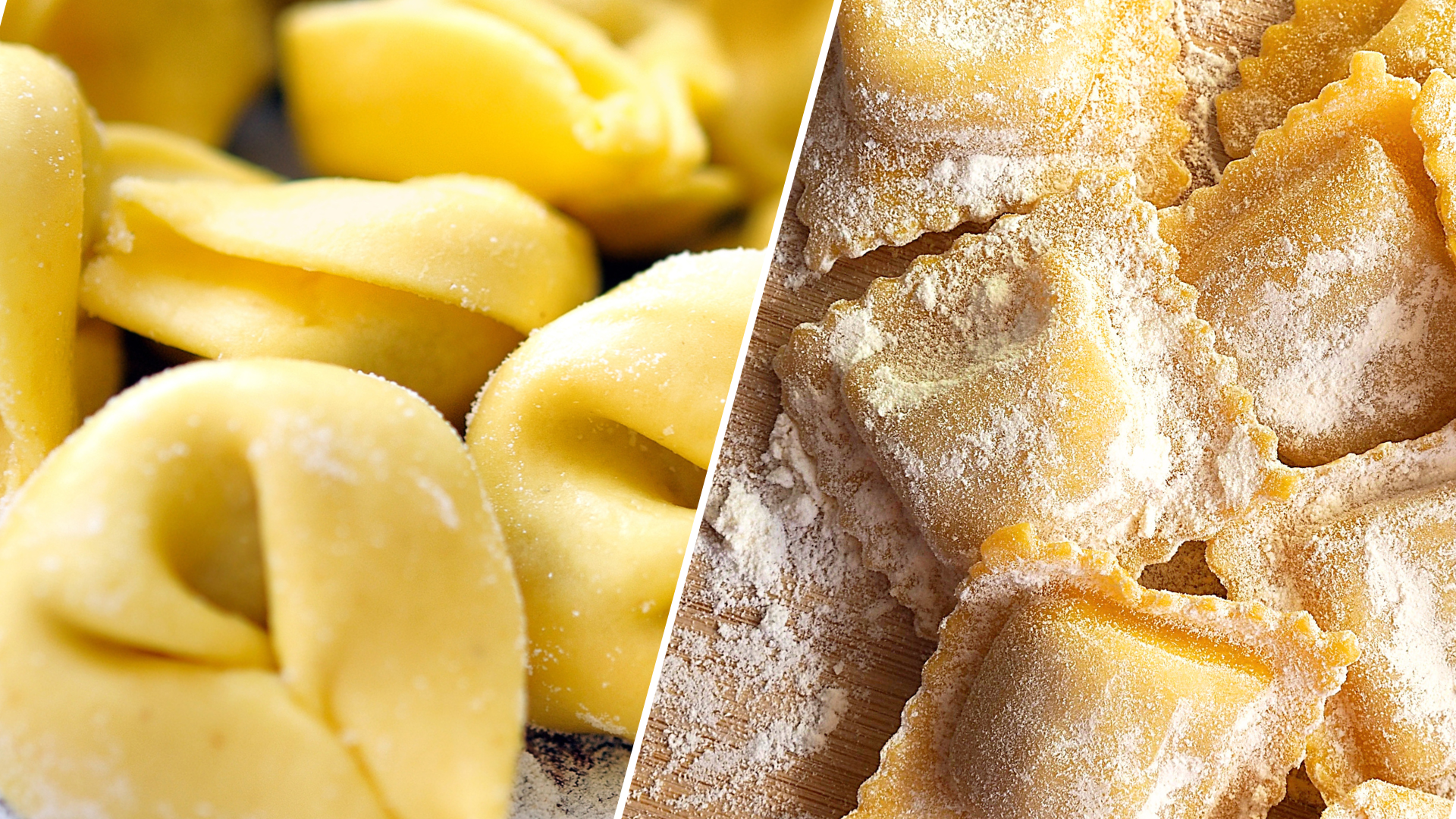Some of the links on this page are affiliate links, which means that Buzzy Kitchen earns commission from purchases made – at absolutely no extra cost to you. Thank you so much for supporting Buzzy Kitchen!
Today, we will embark on a journey to explore the exquisite flavours and unique shapes of two beloved Italian pasta varieties, popular all across the globe. Both are stuffed, delicious, and easy to cook, but are tortellini and ravioli the same thing? If not, what makes them different?
Let’s raise our forks and begin this savoury expedition into the delightful world of these two Italian pastas and uncover the real similarities and differences.
What is Tortellini Pasta?
Tortellini originates from north Italy but is now a firm favourite of pasta lovers all around the globe. Starting with small squares of pastry dough, they are filled with one or more of: vegetables, cheese, or meat. Following that, they are folded in a triangular way around the finger in such a way that they look like a ring or hat.
Traditionally, tortellini were filled with ricotta cheese, but over the years, various tweaks and customisations have been made. These days, you’ll find various hams and meats, countless cheeses, and vegetarian or vegan fillings.
I spent a few minutes looking, and these are the different flavours and fillings I found ready-to-buy in British supermarkets:
- Spinach and Ricotta
- Sausage and Ham
- Chicken and Chorizo
- Four Cheese
- Cheese and Tomato
- Bolognese
- Butternut Squash
- Aubergine Parmigiana
- Carbonara
There are several potential origins of tortellini pasta, including Italian Renaissance chef Bartolomeo Scappi, with a 1570 recipe for “torteletti”. Other people believe the recipe stems from an 1800 legend featuring Venus. The legend even lent itself to another name for the pasta: “ombelico di Venere,” which means Venus’ navel. The pasta looks a little like a bellybutton for that reason. (Nice, right?!)
Fun fact: Tortellini is the plural. If you have one piece of pasta on your plate, you have one tortellino left.

What is Ravioli?
Usually in the shape of small squares, ravioli is a thin egg pasta ‘packet’ with some sort of filling inside and is a type of Italian dumpling. The edges are sometimes fork-frilled or stamped, while the base is completely flat. The top side has a protruding dumpling (the filling ingredients).
Other shapes and types of ravioli include:
- Mezzelune – the word means “half moons” in Italian, due to their semi-circular or crescent shape
- Circular – literally circular instead of square
- Ravioloni – the word means “big ravioli,” due to their larger size than typical ravioli
- Ravioli gigante – which is, as you might’ve guessed, even bigger still
- Ravioletti – square or round, smaller versions of typical ravioli
The first mention of the dish is believed to be in letters from around the 14th century, which makes ravioli at least seven centuries old. Back then, the typical ravioli dinner would consist of beaten eggs, cheese, and various chopped herbs served up in a bowl of either soup or broth. Some foodie experts believe the origins lie in the need to spice up leftovers, but the true point of origin isn’t known.
These days, fillings are usually along the lines of ricotta, spinach and ricotta, beef, pork (particularly prosciutto), cheese, and/or vegetables. The egg pasta parcels are also served up in tomato-based sauces and flavoured with Italian herbs, such as oregano, basil, and plenty of garlic.
Fun fact: Raviolo is one piece of pasta, but ravioli is the plural. Raviolis is also common in today’s language.

Are Tortellini and Ravioli the Same Thing?
No, tortellini and ravioli are not the same thing.
They have several key differences in terms of shape, filling, preparation, and serving styles. Let’s break them down.
Origin
While both pasta types originate from Italy, the origins are quite hotly debated. They are both thought (by some) to have originated in northern Italy, but ravioli is more widespread and dates to as far back as the 14th century.
Tortellini is considered a specialty from the Emilia-Romagna region of Italy, specifically Bologna. The earliest findings of the pasta dish are from the 1500s. Back in those days, pasta would have been a luxury dish, quite different to today.
Size
Tortellini is usually smaller than ravioli. The pastry dough might start out the same size, but the preparation process, particularly the folding, means that the finished ravioli product is larger. In reality, ravioli is made with two pieces of flat pasta whereas tortellini are made with one.
There are different sizes and types of both ravioli and tortellini though… as if life weren’t complicated enough, right?
Shape
Ravioli is often square or rectangular, but you can get the pasta in different shapes, such as circular or semi-circular. Tortellini pasta, on the other hand, is ring or hat shaped.
Fillings
There are different fillings for both ravioli and tortellini, but traditionally, tortellini has a filling of cheese, meat, vegetables, or a mix of two or more. The most well-known tortellini type is known as “tortellini en brodo,” which is served in a flavourful soup or broth, usually a very aromatic and hearty one.
Ravioli is filled with a greater variety of fillings – seafood, meat, vegetables, cheese, and more.
Serving Style
Most tortellini dishes are served in broth, similar to a soup with noodles. Ravioli is more often served in a sauce rather than broth, usually tomato-based (marinara). Pesto and alfredo-style sauces are also common… and delicious.
Similarities
Aside from being types of pasta, tortellini and ravioli do have other similarities, too. Let’s look at a few of them.
They both:
- Have similar cooking times
- Are hearty and satisfying
- Are types of pasta parcels filled with a filling
- And are super versatile Italian foods
Tortellini and Ravioli: Conclusion
In conclusion, while both tortellini and ravioli are delicious types of Italian pasta filled with various ingredients, they have several differences, such as size, origin, filling, shape, and more. They both have their unique appeal, of course.
I’m team ravioli… but which one are you?

You might also like:
